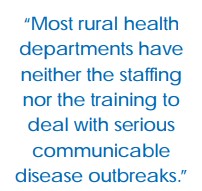Study Purpose
Local health departments are central to sustaining public health in Kansas. In an effort to assure the quality of services provided by local health departments, the Kansas Association of Local Health Departments (KALHD) initiated the development of minimum standards for core functions of public health.
The Kansas Health Institute (KHI), in collaboration with KALHD and the Kansas Department of Health and Environment (KDHE), conducted an assessment of the capacities of local health departments to meet standards in five areas: communicable disease; immunization; sexually transmitted disease (STD); tuberculosis (TB); and, human immunodeficiency virus/acquired immune deficiency syndrome (HIV/AIDS).
While the standards assessment process in Kansas was initiated before the recent escalation in concern about bioterrorism, the findings and implications of this study now have even greater relevance to protecting and promoting the health of Kansans. This report summarizes findings from this 2001/2002 assessment.

Primary Findings
-
- Local health departments are doing well in some standards areas. Approximately one-third of the standards under consideration were fully met by all or nearly all health departments in this assessment.
- Written policies, procedures, and protocols are a challenge for many local health departments. Written policies and protocols are important requirements of the KALHD standards. Most local health departments conduct daily business without written documentation by relying on the knowledge and experience of their staff.
- Childhood immunization rates are lower than the standards require. Local health departments in less populated counties tended to report relatively higher immunization rates. According to those interviewed, immunization rates in more urban counties were lower due to the mobility of the population served and the inability to track and report immunizations given by the private health providers available in those communities.
- Local health department promotion and oversight of immunizations provided by the private sector does not occur as required by the standards. There is poor compliance with this requirement because the concept is not supported by many local health department staff.
- Most local health departments are not actively involved in HIV/AIDS prevention activities. Some health departments provide HIV/AIDS services that meet the criteria for providing counseling, testing, and basic educational material. However, compliance with standards on community-based prevention efforts and collaboration was generally low.
- Most rural health departments have neither the staffing nor the training to deal with serious communicable disease outbreaks. Smaller local health departments were more likely than larger ones to lack the capacity required by the KALHD standards to deal with communicable disease crises.
Assessment Process
To conduct this assessment, a tool was developed to measure the health departments’ status of compliance with the KALHD standards. Twelve representative sites were chosen for assessment to provide a cross section of Kansas local health departments based on population density and geographic location.
A team of at least two but typically three or more evaluators consisting of representatives of KHI, KALHD and KDHE visited each site. At each site, the standards were assessed independently to determine whether or not the health department was in full compliance with the standard, and if not, what changes would be necessary to achieve full compliance.
Implications
The patterns of compliance and non-compliance in these five standards areas across the twelve local health departments included in the study were generally consistent. This suggests that the findings are likely to be representative of local health departments in Kansas that were not included in the study as well.
The assessment identified a number of areas in which local health departments are not in compliance with existing standards. Careful consideration of options to best resolve compliance issues is necessary to address these complex challenges and insure that local health departments in Kansas are prepared to play their crucial role in safeguarding the health of people in our state.
This work was performed under contract to KALHD with funding provided by the Kansas Health Foundation, a Wichita-based philanthropy dedicated to improving the health of all Kansans. The contents of this report are solely the responsibility of the authors and do not necessarily represent the views of the sponsoring or funding organizations.
